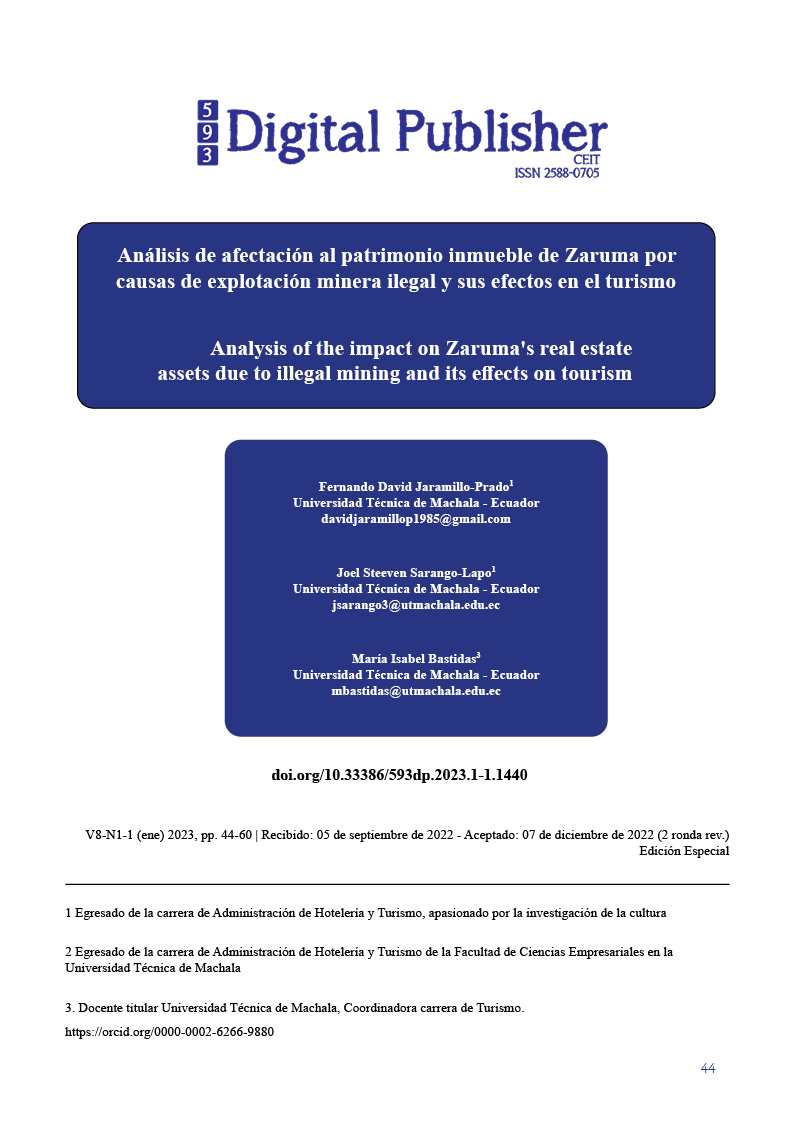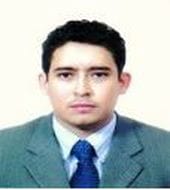Analysis of the impact on Zaruma's real estate assets due to illegal mining and its effects on tourism Analysis of the impact on Zaruma's real estate assets due to illegal mining and its effects on tourism
Main Article Content
Abstract
The present work characterizes the affectation to the real estate and tourism caused by illegal mining activity developed in Zaruma canton, El Oro Province, known as a city that has emblematic cultural heritage and whose economy is largely based on mining exploitation. This activity is a problem for its inhabitants and environment, since it is carried out illegally and creates irreparable consequences for the environment; mining has been present since remote years, thus generating a lack of control in the upper part of the province. Therefore, the main objective of the research is to analyze the impact of mining on the real estate heritage and its repercussions on the tourism sector. Therefore, a descriptive research was emphasized, taking a general vision for the explanation of the problem and through the application of a mixed methodology, which through the use of data collection instruments such as the survey and interview to the settlers and at the same time the execution of the observation technique, therefore, In conclusion, the results show that illegal mining has directly affected heritage assets, essentially real estate, and has also affected the tourism sector, given that real estate is one of Zaruma's main attractions, tourism has obviously been reduced, generating job losses and loss of income, among other things.
Downloads
Article Details

This work is licensed under a Creative Commons Attribution-NonCommercial-ShareAlike 4.0 International License.
1. Derechos de autor
Las obras que se publican en 593 Digital Publisher CEIT están sujetas a los siguientes términos:
1.1. 593 Digital Publisher CEIT, conserva los derechos patrimoniales (copyright) de las obras publicadas, favorece y permite la reutilización de las mismas bajo la licencia Licencia Creative Commons 4.0 de Reconocimiento-NoComercial-CompartirIgual 4.0, por lo cual se pueden copiar, usar, difundir, transmitir y exponer públicamente, siempre que:
1.1.a. Se cite la autoría y fuente original de su publicación (revista, editorial, URL).
1.1.b. No se usen para fines comerciales u onerosos.
1.1.c. Se mencione la existencia y especificaciones de esta licencia de uso.
References
Alvarado, J. (2017). Impactos económicos y sociales de las políticas nacionales mineras en. Revista de Ciencias Sociales, 4, 53-64. Obtenido de https://www.redalyc.org/articulo.oa?id=28055641005.
BCE. (2015). Banco Central del Ecuador. Obtenido de Sector Minero: https://contenido.bce.fin.ec/documentos/Estadisticas/Hidrocarburos/cartilla00.pdf
Calle, M., & Sánchez, L. (2020). Análisis turístico y patrimonial del centro urbano de Zaruma-Ecuador. Revista Espacios, 02-13. Obtenido de http://www.revistaespacios.com
CONRED. (2015). GUÍA TÉCNICA DEL PROCESO DE EVALUACIÓN RÁPIDA DE DAÑOS EN VIVIENDA. Guatemala. Obtenido de https://dipecholac.net/docs/herramientas-proyecto-dipecho/guatemala/6-GUIA-TECNICA-DEL-PROCESO-DE-EVALUACION-RAPIDA-DE-DANOS-EN-VIVIENDA.pdf
Cruz, M., Bonisoli, L., & Albarracín, J. (2022). Entre sentido de pertenencia y potencial de desarrollo:la percepción del turismo en los residentes de Zaruma. Revista Eruditus. Obtenido de https://revista.uisrael.edu.ec
EC Instituto Nacional de Estadística y Censo (INEC). (2010). Número de personas dedicadas a la explotación de minas y canteras por cantones en la provincia de El Oro.
EC Ministerio de Minería. (2016). Plan Nacional de Desarrollo del Sector Minero. Quito. Obtenido de http://www2.competencias.gob.ec
Espinoza, M., Bravo, A., & Vilela, W. (2020). La contaminación ambiental ocasionada por la minería en la provincia de El Oro. Estudios de la Gestión: revista internacional de administración, 8, 215-233. Obtenido de https://doi.org/10.32719/25506641.2020.8.8
Fueyó Editores. (2019). Nuevo manual los minerales críticos y estratégicos en la nueva economía. Rocas y minerales: Técnicas y procesos de minas y canteras,. Dialnet(565), 12-13. doi:0378-3316
González, M., & Puga, I. (2011). Programa de turismo rural para los cantones de Zaruma y Portovelo-Provincia de El Oro-Ecuador. Obtenido de Library: https://1library.co/document/y8g2k60z-programa-turismo-rural-cantones-zaruma-portovelo-provincia-ecuador.html
Guerrero, M. (2016). La Investigación Cualitativa. INNOVA Research Journal, 1-9. doi:https://doi.org/10.33890/innova.v1.n2.2016.7
INEC. (2010). Instituto Nacional de Estadística y Censo. Recuperado el Agosto de 2022, de Censo de Población y Vivienda 2010: http://redatam.inec.gob.ec
INPC. (s.f). Inmueble / Bienes inmuebles. Recuperado el 08 de 2022, de Sistema de Información del Patrimonio Cultural Ecuatoriano (SIPCE): http://sipce.patrimoniocultural.gob.ec:8080/IBPWeb/paginas/busquedaBienes/resultadoArbolNavegacion.jsf
Instituto Nacional de Patrimonio Cultural. (2014). Patrimonio Cultural Material. Loja: Editorial Gráficas Hernández. doi:978-9942-07-673-1
Instituto Nacional de Patrimonio Cultural. (2022). INPC realiza evaluaciones técnicas a los bienes patrimoniales del Museo de Zaruma. Obtenido de https://www.patrimoniocultural.gob.ec
Kuznik, A., Hurtado, A., & Espinal, A. (2010). El uso de la encuesta de tipo social en Traductología. Características metodológicas. Monografías de Traducción e Interpretación, 315-344. doi:1889-4178
López, M., Santos, J., Quezada, C., Segura, M., & Pérez, J. (2016). Actividad minera y su impacto en la salud. Revista Ciencia UNEMI, 95-100.
Lule, N., & Campos, G. (2012). “LA OBSERVACIÓN, UN MÉTODO PARA EL ESTUDIO DE LA REALIDAD”. Revista Xihmai, 49-60.
Massa, P., Arcos, R., & Maldonado, D. (2018). Minería a gran escala y conflictos sociales: un análisis para el sur de Ecuador. Revista Problemas del desarrollo, 3-23. Obtenido de https://www.scielo.org.mx/scielo.php
Mercado, E. (2010). Conservación del patrimonio edificado y políticas públicas: del concepto a la práctica en el estado de Michoacán, México. Redalyc, 15-26. doi:1870-7483
Ministerio de Energía y Minas. (2022). Acciones gubernamentales en zaruma avanzan a paso firme. Obtenido de https://www.recursosyenergia.gob.ec
Naranjo Villavicencio, M. (2009). La Cultura Popular en el Ecuador. (CIDAP, Ed.) DSpace, 159. doi:978-9978-85-041-1
Naranjo, M. (2009). La Cultura Popular en el Ecuador. (CIDAP, Ed.) DSpace, 159. doi:978-9978-85-041-1
Orellana, I., Briére, L., & Rodríguez, F. (2020). La resistencia social en contexto de conflicto socioecológico: un crisol de desarrollo de las dimensiones crítica y política de la educación ambiental. Ambiente & Educación, 1(25), 13-45. doi:13-45. 10.14295/ambeduc.v25i1.11117.
Ortega Jaramillo, J. D. (2016). La vida en las minas zarumeñas. Obtenido de http://dspace.ups.edu.ec
Otzen, T., & Manterola, C. (2017). Técnicas de Muestreo sobre una Población a Estudio. Revista International Jorunal of Morphology, 228-232. Obtenido de https://www.scielo.cl/scielo.php
Palma, J. (2013). El patrimonio cultural, bibliográfico y documental de la humanidad. Revisiones conceptuales, legislativas e informativas para una educación sobre patrimonio. Revista de Cuicuilco. Obtenido de http://www.scielo.org.mx/scielo.php
Pérez, M., & Betancur, A. (2017). Impactos ocasionados por el desarrollo de la actividad minera al entorno natural y situación actual. Redalyc, 95-112. doi:2007-6576
Pinilla Pedraza, C. P., & Santos Morán, C. Y. (2014). La minería ilegal arrasando las entrañas de la tierra. Mundo Amazónico, 5, 455-475. doi:10.15446/ma
Román, J. (16 de Diciembre de 2020). Zaruma se hunde por la minería clandestina. Lo ocurrido en Zaruma ‘evidencia las nefastas consecuencias de la minería ilegal’, pág. 1.
Saénz , J., Suárez, N., & Mero, J. (2016). Elementos esenciales del diseño de la investigación. Sus características. Dominios de la Ciencias, 2, 72-85. doi:2477-8818
Ulloa, K. (2019). “LA MINERÍA ILEGAL Y LA VULNERACIÓN DE LOS DERECHOS DE LA NATURALEZA. Obtenido de https://repositorio.uta.edu.ec
UNESCO. (2011). Patrimonio Cultural un enfoque diverso y comprometido. Mexico: Impresion Danda.
UNESCO. (2017). Manual Metodológico: Patrimonio. Obtenido de https://es.unesco.org/creativity/sites/creativity/files/digital-library/cdis/Patrimonio.pdf
Vásconez, M., & Torres, L. (2018). Minería en el Ecuador: sostenibilidad y licitud. Revista Estudios del Desarrollo Social: Cuba y América Latina. Obtenido de http://scielo.sld.cu/scielo.php
Vilela, W., Espinosa, M., & Bravo, A. (2020). La contaminación ambiental ocasionada por la minería en la provincia de El Oro. revista internacional de administración. Obtenido de https://revistas.uasb.edu.ec



